An individual approach to every project includes the work of many tech-savvy experts, negotiations, planning, and the accomplishment of deadlines and clients’ requirements. To standardize such a challenging process, software development methodologies and frameworks are widely used by companies and customers.
This article will describe the most popular software development methodologies and take a look at some of their frameworks.
What Are Software Development Methodologies?
A development methodology is a way of software creation. The order of the development stages and a work schedule vary due to the task complexity, or personal requirements.
You can see the most popular methodologies due to GoodFirms statistics below:
Waterfall
Waterfall is a strict approach that requires specific results in every building phase. And each stage should be fully completed before proceeding to the next one.
Waterfall comprises six stages:
- Discovery. Defining all the product requirements.
- Design. Solution Architects clarify the building process of the software.
- Coding. Developers build the UI design following the client’s needs.
- Testing. QA engineers test the product to detect bugs and other issues.
- Deployment. The demo version is assembled and checked by the stakeholder.
- Support. Specialists maintain and update the product.
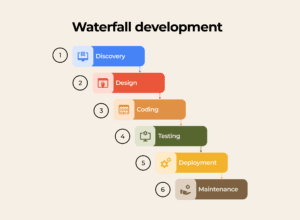
Let’s list the pros and cons of Waterfall:
Pros:
- Well-scheduled and structured methodology
- Beneficial for a fixed budget and complex requirements
- Fewer client involvement needed during the development flow
- Simple final cost calculation
Cons:
- Defined and detailed project requirements needed
- Discovery phase takes more time
- Inflexible planning stages
These drawbacks have caused the replacement of Waterfall by Agile software development. Besides, Agile’s success rate is higher (42% vs. Waterfall’s 26%), and the failure rate is three times lower. So nowadays, Agile is more advantageous.
Agile
Agile is a widely-used methodology applied in companies of various scales. The main principle of Agile is to divide the entire development flow into repetitive sprints, one of which takes 1-4 weeks and is devoted to building each feature.
After launching, the team gathers feedback and proceeds to the next sprint.
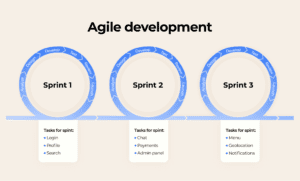
This development methodology is suitable for complex and sophisticated projects (over 300 hours) or when not all the building stages are clear.
Pros:
- Often releases (once/twice monthly)
- Flexible, adaptive
- A working product is released after each sprint
- The client is more engaged in the development, so there’s a higher chance all their requirements will be met
- The team works closely and has a clear vision of their responsibilities
Cons:
- Needs attentive management
- Lack of cost estimate and deadlines
- Requires highly competent and executive teammates
To maximally benefit from Agile, companies usually involve a Project Manager to guide and control the whole team.
Agile Framework #1 — Scrum
In comparison with methodologies, frameworks have more defined regulations and precise standards.
Scrum is one of them. All the sprints begin with an outline and finish with a smooth, seamless product.

Vital points which make the development process efficient and adjustable:
- Sprint planning. The development team arranges a meeting with customers to define primary features and schedule the following workflow.
- Daily meetings. Teammates conduct daily morning meetings to discuss their advancement in their aims, daily plans, and challenges.
- Demo. Project Manager keeps the clients up with the progress and receives their reviews.
- Retrospectives. Teammates arrange a meeting to discuss the development obstacles, sprint issues, and ways to overcome them.
This way, the team is more productive, detects and copes with the issues easily, quickly, and establishes high-quality communication with the customer.
Pros:
- Delivering a product every 2-4 weeks
- Suitable for undefined requests
- Very adaptive and changeable
- Daily team discussions
Cons:
- Doesn’t suit teams with insufficient self-discipline
- Requires high client involvement
- Needs contribution from every team member
Agile Framework #2 — Kanban
Kanban offers higher adaptiveness since the tasks in progress are prioritized.
The Kanban principle:
- The development is split into phases and assignments.
- Tasks are displayed in the form of cards on the panel.
- The fulfilling consists of columns (three minimal) — To do, In progress, Done.
- During the performance of tasks, cards should be moved between columns, from left to right.
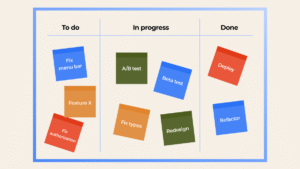
Trello or Jira is in use by the team to receive assignments. Or you may use a usual board and put stickers on it.
There are principles similar to Scrum, such as daily meetings, demos, and retrospectives. Yet, there are no split phases, the assignments are created and put on the panel gradually after completing the previous one. Thus, the team increases its productivity and raises the number of weekly releases.
Pros:
- Efficient task tracking
- Flexible approach
- Suitable for supporting projects
- Doesn’t require re-planning when requirements change
Cons:
- No sprints which can affect the progress
- Requires self-management skills of teammates
- Difficulties in operating the scope of work
Agile Framework #3 — Extreme Programming
Extreme programming (XP) is more about software development principles rather than task monitoring and management.
- Test-driven development. The development flow begins with acceptance tests, not code.
- Code review. Fellow developers check each other’s code to detect issues.
- Refactoring. Editing readymade code.
- Pair programming. Two programmers fulfill one task in turn.
- Continuous integration. New code elements are regularly implemented into existing ones.
- Unit testing. Automated testing of built features to make sure they perform smoothly.
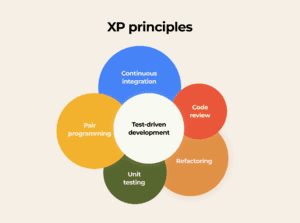
However, XP is not frequently used, but certain principles are applied separately for a particular case.
Pros:
- Transparent code
- Quick MVP development
- Less documentation needed
- Adjustable for varying requirements
Cons:
- More customer engagement
- More time-consuming (work of two programmers)
- May be insufficient documentation
#3. Lean Development Methodology
This methodology is quite adaptive like previous ones but has certain peculiarities.
Let’s compare Agile and Lean Development:
| Point | Lean | Agile |
| Customer | Create value for the client; concentrate on value-adding activities | Build a project meeting all the client’s requirements |
| Rapidity | Fast value creation, short stage times | Regular delivery of an operating product |
Lean is also ascribed to an MVP concept as it also comprises the product with essential functionality and is aimed at gathering first users’ feedback for further improvement.
You may overview primary Lean norms regarding teams and clients:
- Eliminate Waste. Wasteful activities imply additional features, unfinished tasks, delays, drawbacks, etc.
- Deliver Fast. Develop an MVP product time-efficiently, detecting the issues which affect productivity.
- Delay Critical Decisions. Decide on significant solutions only when you possess all the essential information.
- Amplify Learning. Collect clients’ suggestions to meet the users’ wishes.
- Build In Quality. Maximize product quality during the coding phase.
- Optimize the Whole. Enhancing the whole development process, not the single stage.
Respect People. Maintain good and productive communication among the team.
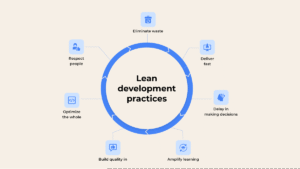
Startups apply Lean to quickly create an MVP and track its performance in a real environment on the market. As a result, they update and refine the product.
Pros:
- Suitable for newly-established startups
- Quick creation and increased productivity
- Fast time-to-market
Cons:
- The customer has to confide in the team’s solutions
- Requires thoughtful documentation
Software Development Processes and Methodologies: Full Comparison
Your project and requirements allow better defining the development methodology. So every case should be considered separately. Startups should go for Agile or Lean since they will adapt the workflow to their projects. In case your aim is to enhance a large-scale company platform following strict regulations and detailed documentation, you’ll benefit from Waterfall.
Frameworks and methodologies, suitable cases, and customer involvement:
| Methodology | Suitable cases | Customer involvement |
| Waterfall | Enterprise software with clear documentation | High only during the discovery phase |
| Agile | For projects of all scales | Customer gives feedback and suggestions |
| Scrum | Complex projects | Customer’s feedback is prioritized |
| Kanban | Updating, maintenance, support, fixing bugs | Owner assigns and reviews the work |
| Extreme Programming | Coding following strict deadlines | Customer sets priorities, defines requirements and deadlines |
| Lean | For startups, faster MVP | Customer defines sample screens and initial user stories |
Wrapping Up
To raise the productivity and efficiency of the development process and get the highest quality of the final product, you should choose the most appropriate development methodology specifically for your case. Analyze your aims, purposes, the scale of work, task complexity, and requirements. Thus, you will find out which creation phases to prioritize and how flexible the process should be.
Applying a proper methodology or framework makes all stages more transparent, well-planned, and organized. A competent expert will always consult you and help select the best approach for you.

